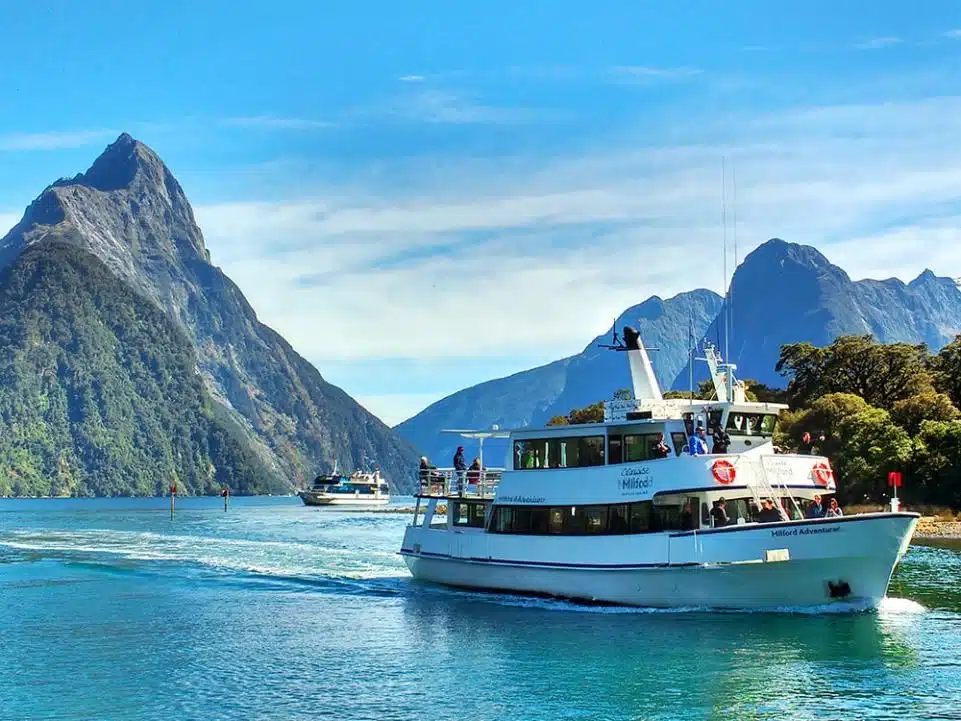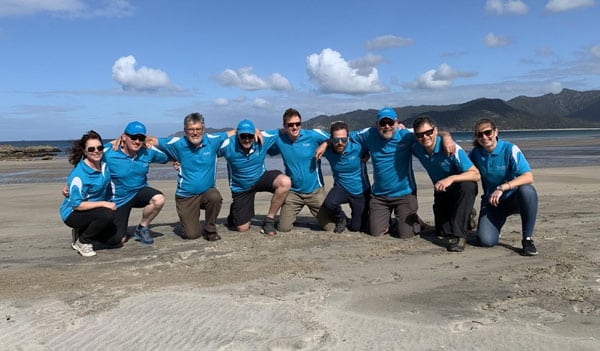Toni and her husband Tony travelled with Kiwi Guide Tim for nine fun filled days exploring the very best of the South Island. During her trip Toni kept a travel diary and has been kind enough to share it with us.
For anyone who is thinking about visiting the South Island and leaving all the driving and organizing to someone else, you’ll find it a useful article and a great way to work out if a small group tour is the right fit for you.
Thanks to Toni (& Tony!) for joining us on tour and, of course, for sharing their travels with us.
Day 1 – Christchurch – Akaunui Homestead – Aoraki/Mt Cook
The start of our Kea tour!
So – here we go: Tony and I were picked up by our tour guide/driver Tim and drove out of Christchurch City and down the long straight roads of the Canterbury Plains towards Ashburton.
We detoured off that long straight road to Akaunui Farm homestead, the home of our lunch hosts, a couple whose farm property has been in their family for generations. An enjoyable time ensued in a lovely setting around the 120-year house with pre-lunch drinks followed by a very nice smorgasbord meal eaten in the grounds, surrounded by acres of beautiful gardens and trees. Most of the food provided was produced on the farm. Two very personable and entertaining family dogs made friends with all.
After this pleasant sojourn we drove on towards the Southern Alps through the Mackenzie Country, where we stopped at the beautiful site of Lake Tekapo and the Church of the Good Shepherd. Heading on towards Aoraki/Mt Cook, we had brilliant views across the turquoise-coloured Lake Pukaki. The eye-catching colour comes about through extremely fine silt partials – or “glacial flour” – eroding off the glaciers and staying suspended in the water.
Arrived at the Hermitage to breathtaking views of the mountains nearby, seen from every room. Fine weather made for wonderful viewing. The twilight provided an ethereal view of our highest mountain, Aoraki/Mt Cook from our well-appointed rooms.
Already, after just one day’s travel through this beautiful and breathtaking scenery, I can tell I am going to run out of superlatives very quickly, or run the risk of repeating them often!
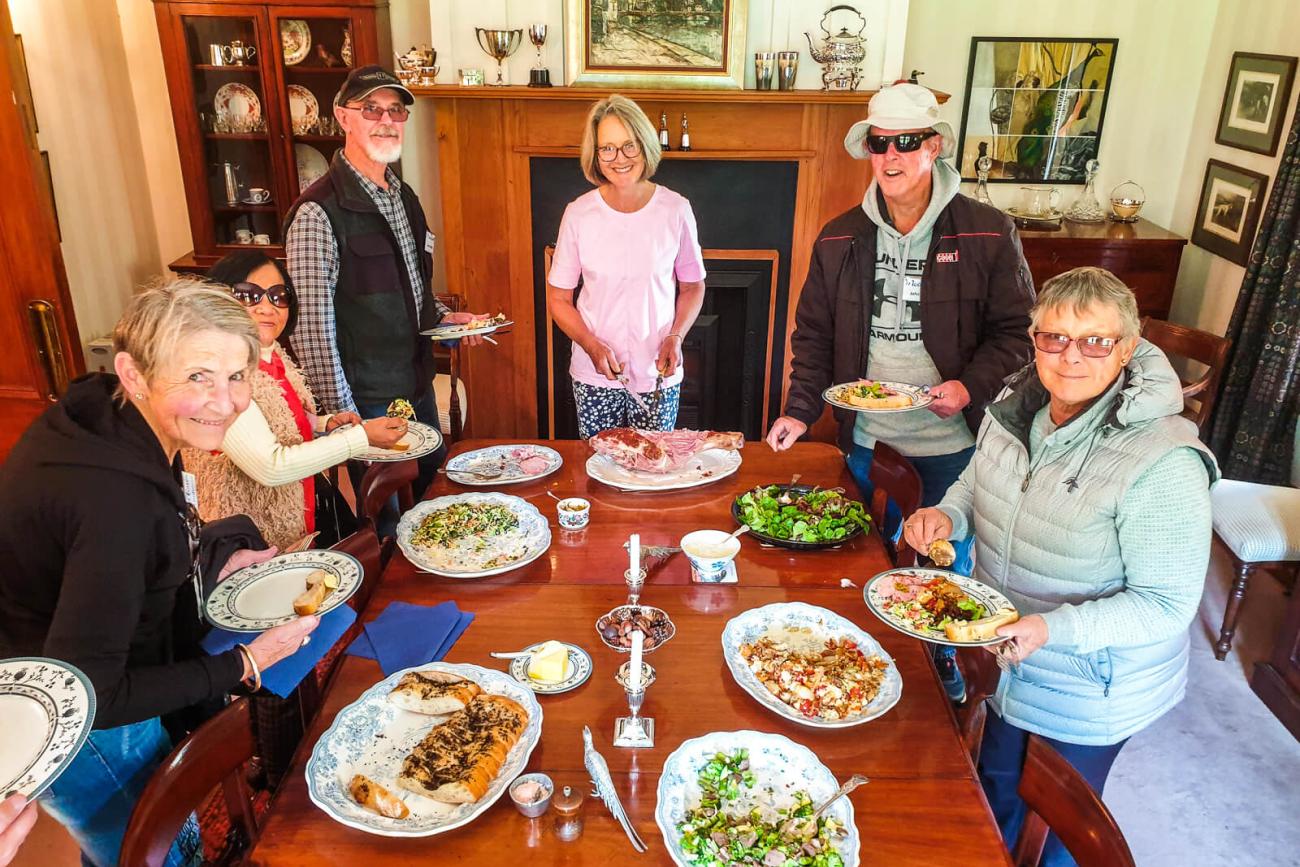
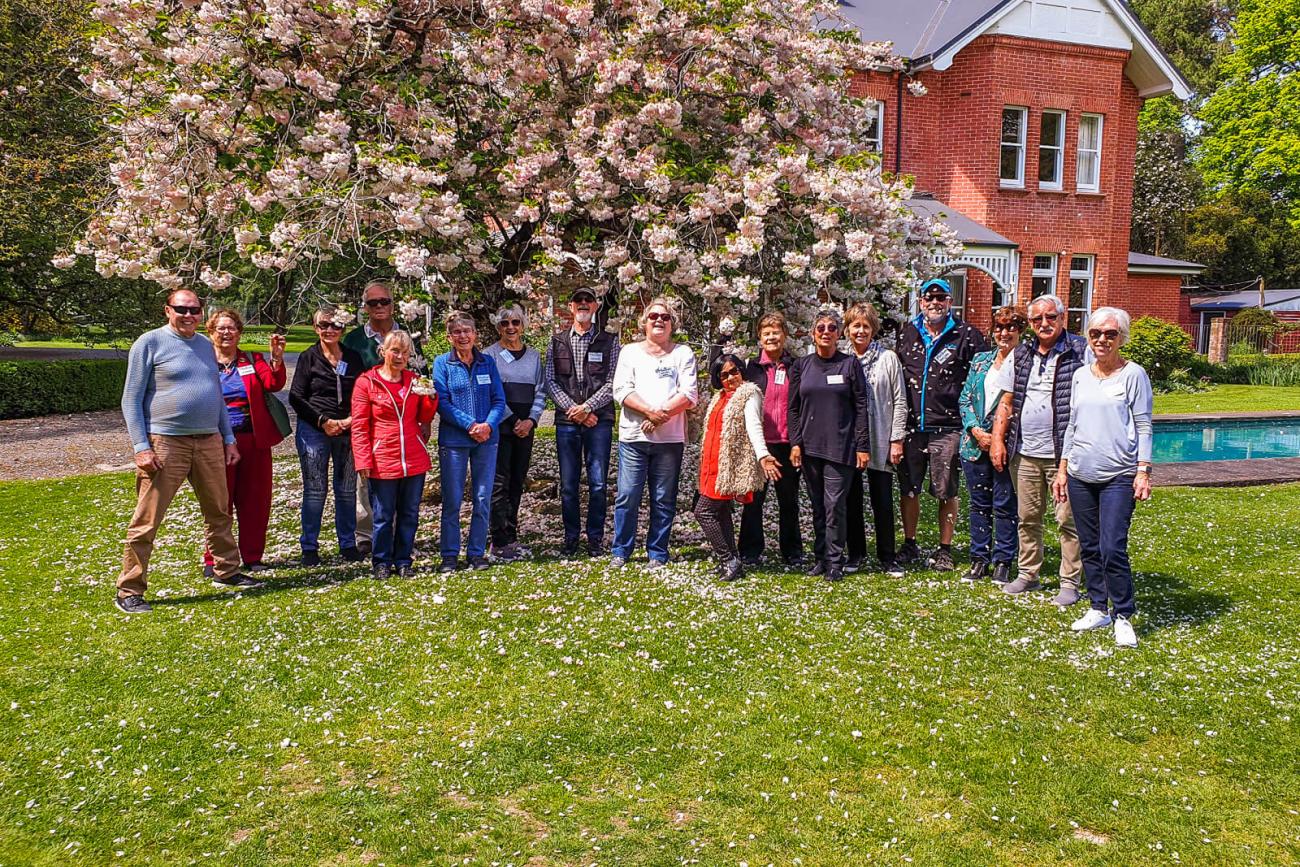
Day 2 – Aoraki/Mt Cook – Queenstown
Tony and I were able to have a leisurely morning while some of the group went for a helicopter ride up over the Tasman Glacier. They landed on the Glacier and were able to walk on it. Other members chose to hike up to its edge, on a steep path with high steps. We had a more casual stroll out along one of the walking tracks towards the mountains. The peace and serenity of the area was like being in another world.
At 11.30am we set off again in the bus to travel down to Queenstown. Once again the scenery was awe-inspiring, travelling along Lake Pukaki for miles, into tussock lands and mighty sweeps of hills. We stopped at the top of Lindis Pass, where we saw a couple of hang gliders soaring off the top of the next hill. And I let slip it was our wedding anniversary so Tim took a photo of us there in the tranquil open space, on a lovely clear, warm day. A nice moment for us.
Further on, we stopped at a fruit outlet that had a wine-tasting department as well. Quite a lot of tasting was done by quite a few of our group, and a number of specialty ports, brandies and wines were purchased. We bought several varieties, and I can advise they were worth every dollar.
We drove into Queenstown around 5pm, over the Shotover River, which is an example of a “braided river” where small channels that are often temporary, run and twist along the river bed. These are a feature of parts of the South Island where high levels of sediment wash down from the ranges. They add to the uniqueness of the area.
On arrival in Queenstown, as we have found on previous visits, the initial sight of Lake Wakatipu with the magnificent Remarkables Ranges soaring above as a backdrop, catches your eye, your breath and something inside – your soul? It makes you feel good to be in this place.
After booking into our hotel, we drove around the sights of the town before having dinner. The building boom has hit the area, with so many subdivisions springing up both in Queenstown and nearby towns. Big $$ required to buy here however!
Tomorrow we have an early start to drive to Milford Sound, and a full day ahead.
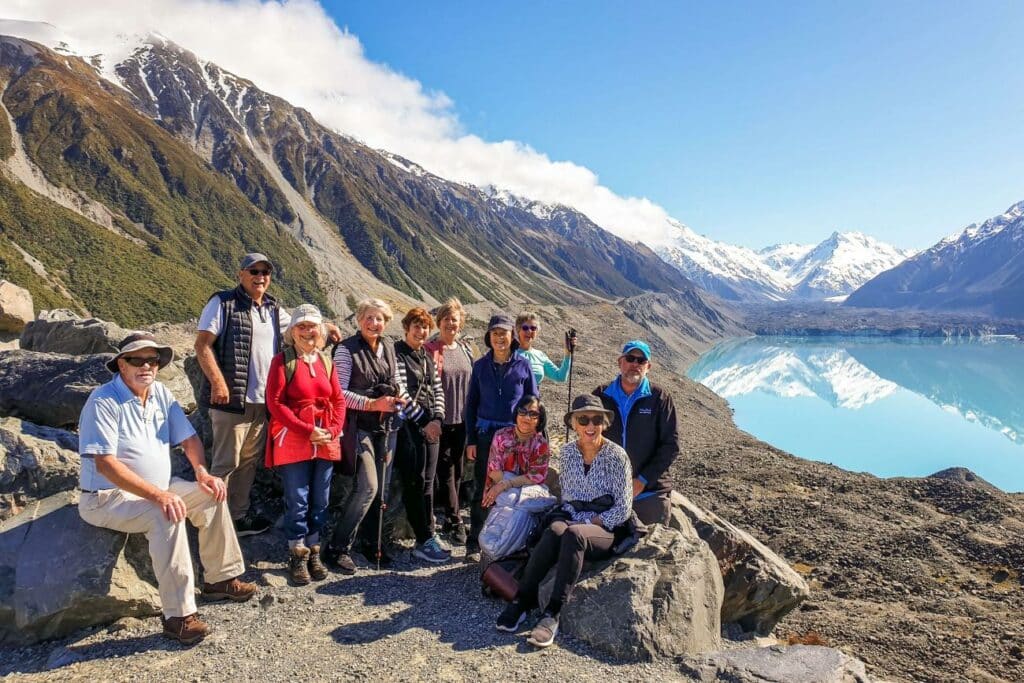
Day 3 – Queenstown – Milford Sound – Queenstown
What a memorable day….
An early start, on the road for a five-plus-hour drive from Queenstown to Milford Sound. Through incredible scenery, towering mountain ranges rising straight up at every point of the compass with their caps and scarves of spring snow. We drove along roads, some winding and dipping into the valleys, originally built during the 1930s Great Depression when men needed work – and what hard toil it must have been. Over rivers, through beautiful beech forests where fallen trees must be left where they fall, to keep the circle of nature continuing; down long slopes then winding up others. We saw deep scars on the mountain sides caused by huge tree avalanches – often the trees’ roots are interwoven and when one falls, it takes many others with it, gouging out soil and vegetation.
We also started to encounter sandflies, but luckily at this time of the year, not a lot! Enough though to quickly shut the vehicle door at our various stops.
We had several photo stops and at one, Tim suggested all the women form a line and do a bit of a “Sound of Music” scene – so we did, plus one man who wasn’t afraid to show his feminine side! The result was a slightly hilarious vision of a line of – in some cases (including my own), somewhat arthritic folk trying to skip, while rendering a rather weird version of “The Hills Are Alive with the Sound of Music”. I doubt Julie Andrews would have recognised or approved of the outcome. We have this recorded on video for posterity, and have a laugh each time we look at it.
Arriving at Milford Sound, we boarded the vessel “Milford Explorer” for what was an awe-inspiring trip around the Sound and out to where the Southern Ocean meets New Zealand’s coastline. The vessel’s captain told us it was rare to have such a fine and smooth trip as the area, being fiord country, has near continuous rainfall. On one shore, we were able to get up near to a very rare tiny Fiordland Crested Penguin, who was bumbling up through the pebbles and rocks like a little old man. Apparently this species is almost extinct, with about 200 breeding pairs left.
The boat was taken up to several waterfalls where those who felt so inclined could get plenty of glacial spray – and quite a few did!
The Sound itself is like travelling through a vast open-air cathedral with the mountain peaks towering majestically above and around, presided over by the famous Mitre Peak. Waterfalls cascade down from the heights, and the whole effect is fantastic.
For our return to Queenstown, we were loaded on to two 12-seater planes for the 35-minute flight. We flew back down Milford Sound and out over the Tasman Sea where it met the coastline, and were lucky enough to see a group of three whales coming up to broach. We circled over them once before leaving them to enjoy their habitat.
We flew on up the coast before turning inland and through a series of valleys. The mountain ranges towered over us as we followed the rivers inland, arriving over Lake Wakatipu then landing at Queenstown Airport. An incredible experience, especially as many of us had not flown in a small plane before and felt a little nervous – some of us admitted afterwards – when surrounded by such a giant landscape in a tiny man made craft!
What a great day. I have used a lot of superlatives here but they still don’t describe the wild beauty and majesty of nature we witnessed today. We did the trip in comfort, but it confirmed to me that next to nature, man is pretty insignificant.
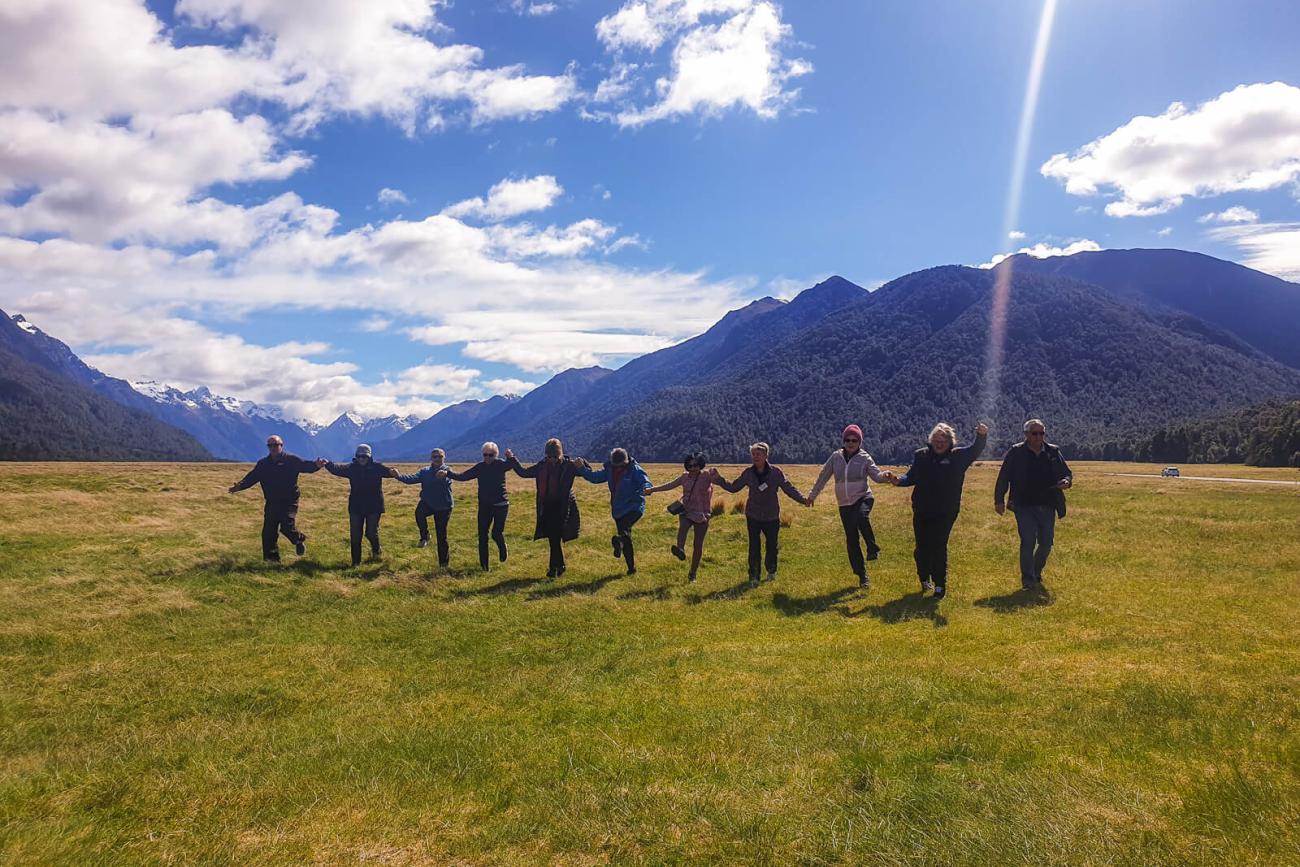
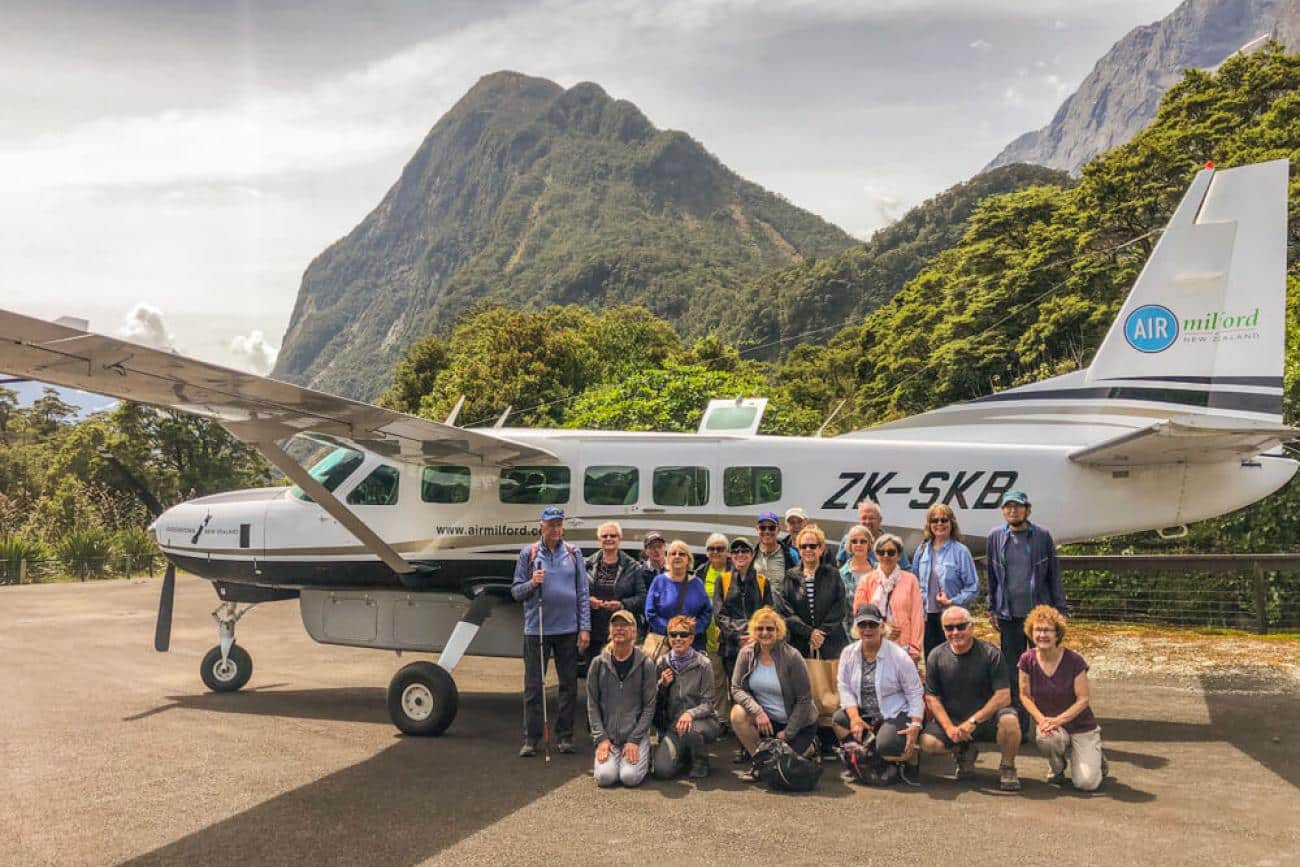
Day 4 – Exploring Queenstown
There were a host of optional activities to choose from today. Some of our group went down to Glenorchy to join the Dart River wilderness jet boat experience. Others went wine touring in the Gibbston valley and e-biking.
Tony and I took a cruise on Lake Wakatipu on the venerable steamship TSS Earnslaw. Arriving back in Queenstown, we checked out the boutique shops then took the gondola to the top of the hill to see the magnificent views of the lake and the Remarkables mountain range.
Later we had dinner at the Boardwalk Cafe overlooking the Lake. Great meals served in a beautiful setting.
Day 5 – Arrowtown – Cardrona – Wanaka
On the move today after three nights based in Queenstown. Drove to Arrowtown, well-known for its history during the Central Otago gold rush in the 1860s. Many of the town’s original old buildings have been preserved and used for modern-day enterprises. It is very pleasant to stroll through. We had morning tea in one of the cafes, and then took a walk down to the Arrow River, where the gold rush started in 1862. Part of the trilogy “The Lord of the Rings” was filmed here.
Leaving Arrowtown, we climbed and climbed up the Crown Range which includes the well-known Coronet Peak Ski Fields. The views back over the Wakatipu Basin were breathtaking. Once again the magnificent scenery in this part of New Zealand is hard to take in all at once, and makes you realise how small man is in comparison to such grandeur (there I go again with the superlatives!).
We stopped at the old Cardrona Hotel for lunch, very pleasant and great food. Naturally a few of us posed with the 1928 Chrysler sedan out front of the pub that is part of the iconic scene.
Driving on towards Wanaka, we came across a fence artistically festooned with literally dozens and dozens of bras – very colourful and obviously a photo-shoot stop. Graham was very promptly elected to be our signature guy posing with this work of art. Have to say he did so very tastefully and resisted suggestions to lower his standards. Good on you Graham.
Our hotel rooms in Wanaka all had views of the Lake. Most of us took a walk along the lakefront to stretch our legs. A nice meal in the hotel restaurant with a few tall tales and jokes from our resident jokester Graham rounded off a pleasant day.
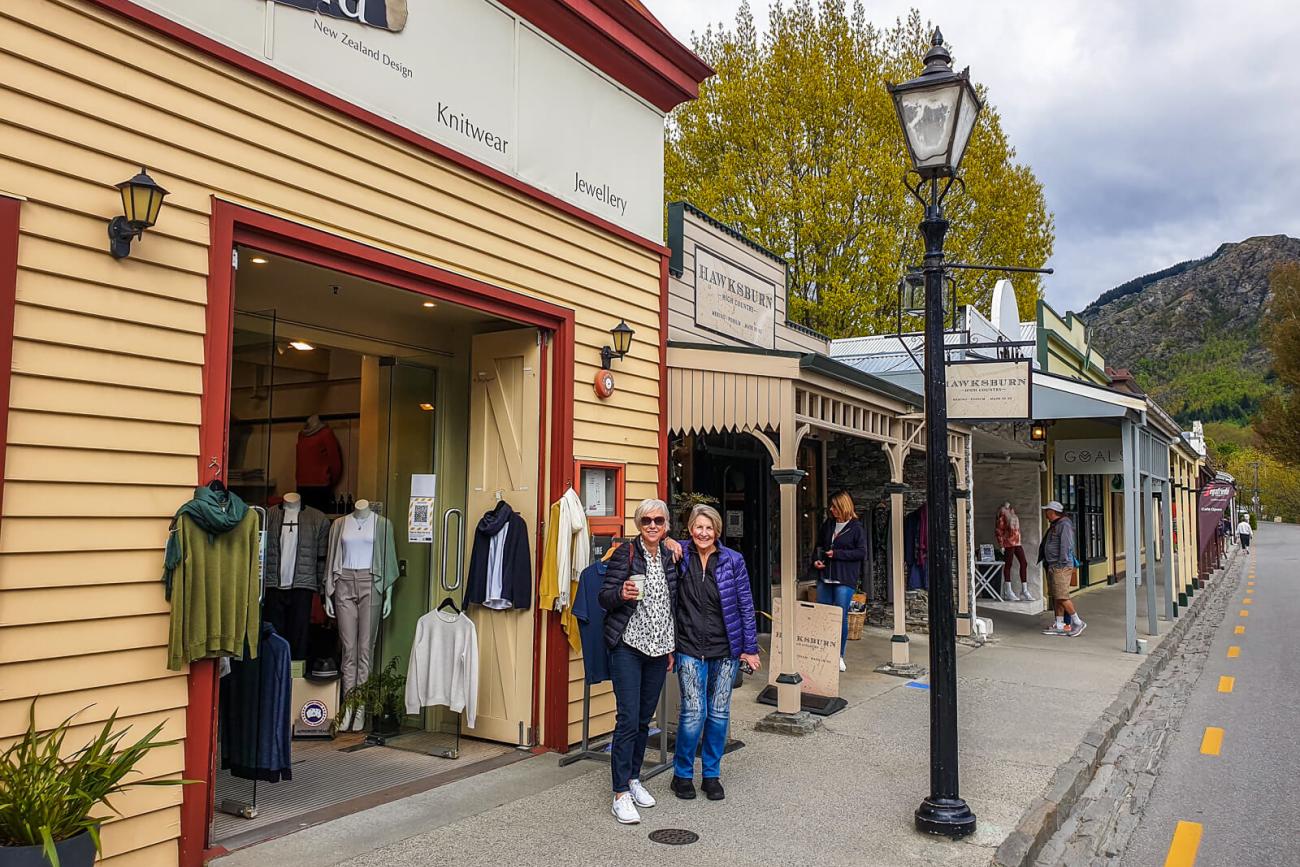
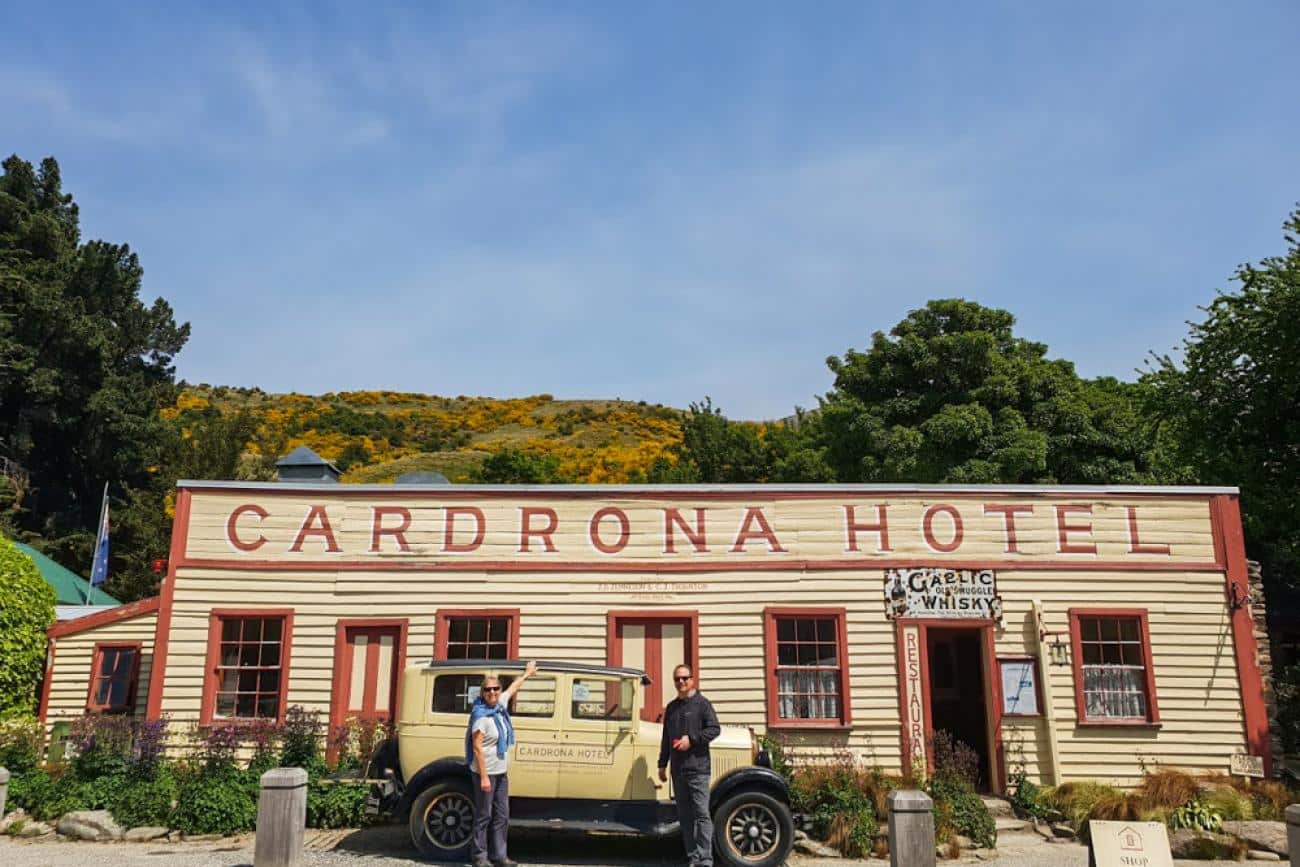
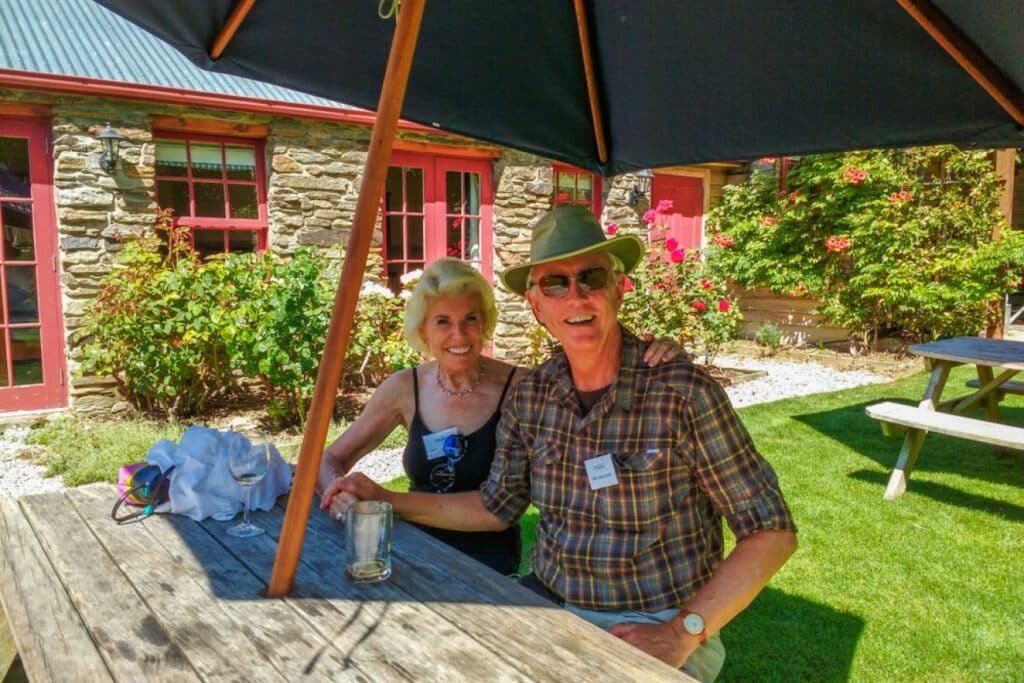
Day 6 – Wanaka – Haast Pass – Franz Josef Glacier
The rain had arrived by the time we left Wanaka this morning, heading for the West Coast via the Haast Pass. Drove along past both Lakes Hawea and Wanaka, where American movie stars and other rich folk own huge tracts of land and luxury homes tucked away in there somewhere. Apparently there are more underground bunkers per capita here than anywhere else in the world – I guess they are set up as bolt holes, if something goes wrong somewhere on our planet.
Drove through Haast Pass in steady rain, the solid curtains of mist hanging from the mountain ranges right down into the valleys. Waterfalls cascaded from the tops of the surrounding ranges, all the more spectacular due to the solid rain.
As we got further into the Pass, Tim pointed out two different fault lines that could be seen amongst the rocky slopes alongside the road – the Australia plate which slides under the Pacific one, and later the Pacific plate which slides under the Australia one. Eerie feeling to know that these huge components of our planet way down under us, are constantly moving and grinding, causing our country’s earthquakes and tremors. Yet another time when nature diminishes man’s importance.
We had a coffee stop at an isolated cafe along the way, which had some interesting toilet doors and a huge collection of vehicle number plates – Tony was in his element with the number plates! Later on we had lunch at the Westland Salmon Farm, with its deep pools dark in the unrelenting rain. It was accessed via a covered boardwalk through native bush, where the only sound was the rain dripping off the trees. It is so damp that several species of ferns and mosses grow on the living trees in the area. And you got it – salmon was on the menu!
In the nearby township a large gathering was attending a wood chopping competition, despite the rain – and the beer was obviously going down well too! They gave us a cheery wave as we travelled through. Good keen West Coast men. And women!
We eventually arrived at Franz Josef township and met later for a happy hour and dinner, everyone got a little crazy and a lot of laughs were had. Good finish to a very wet – but interesting – day.
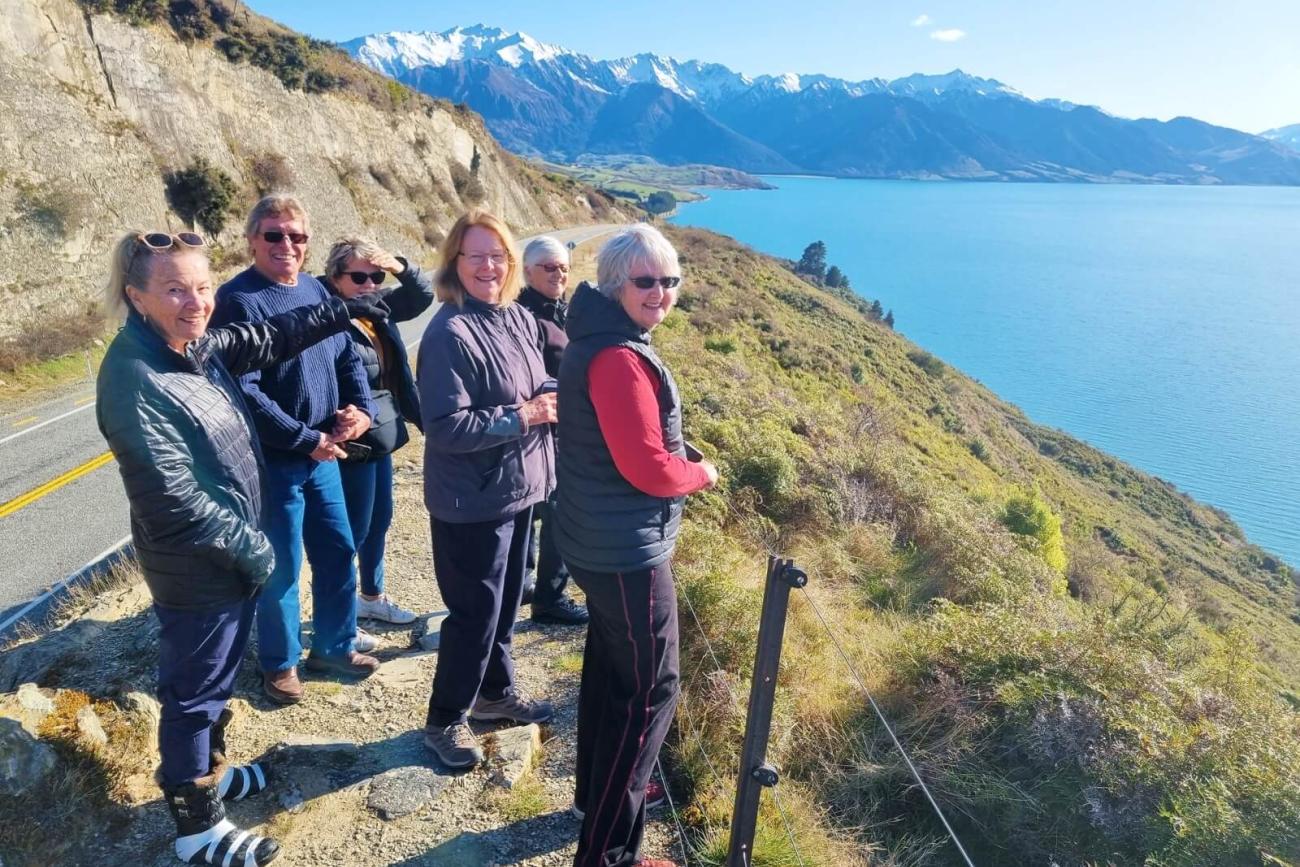
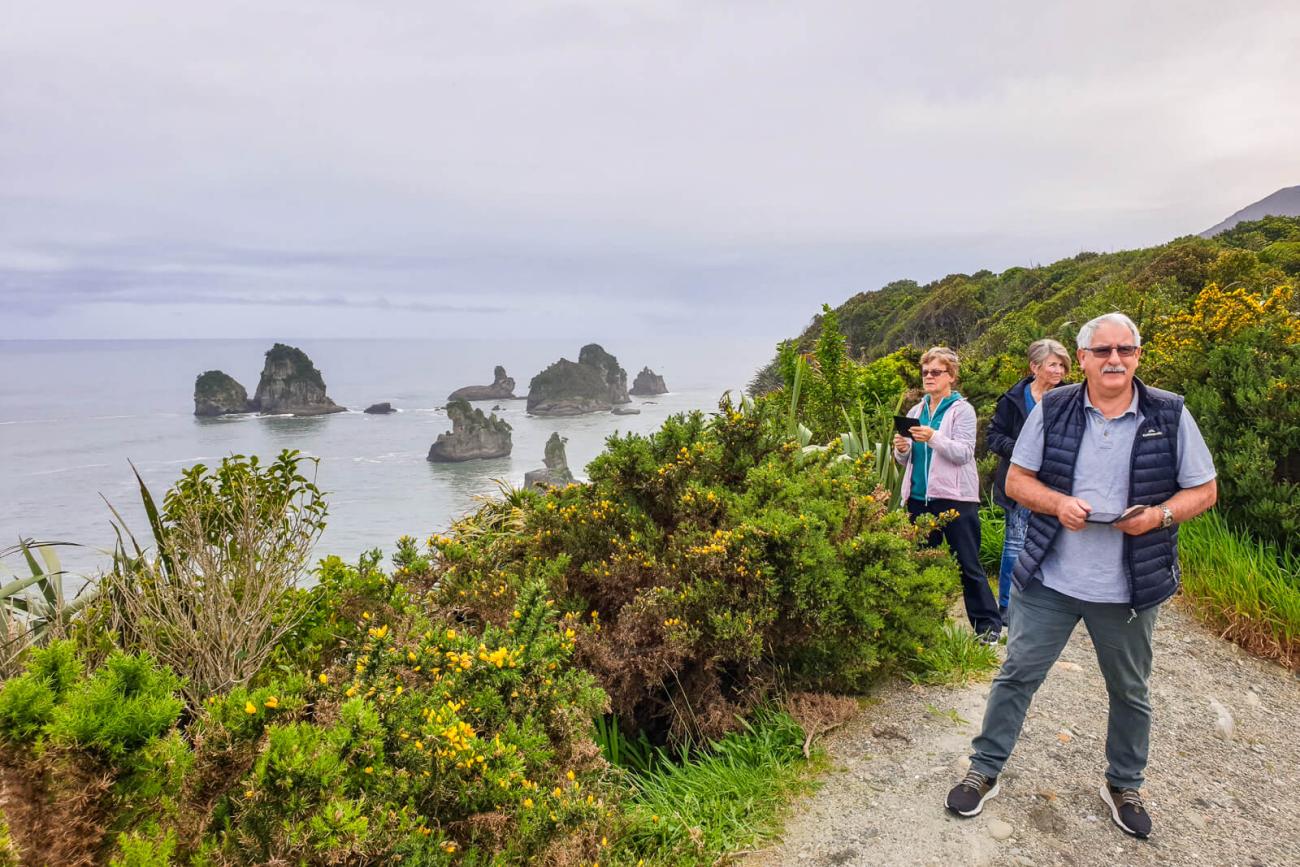
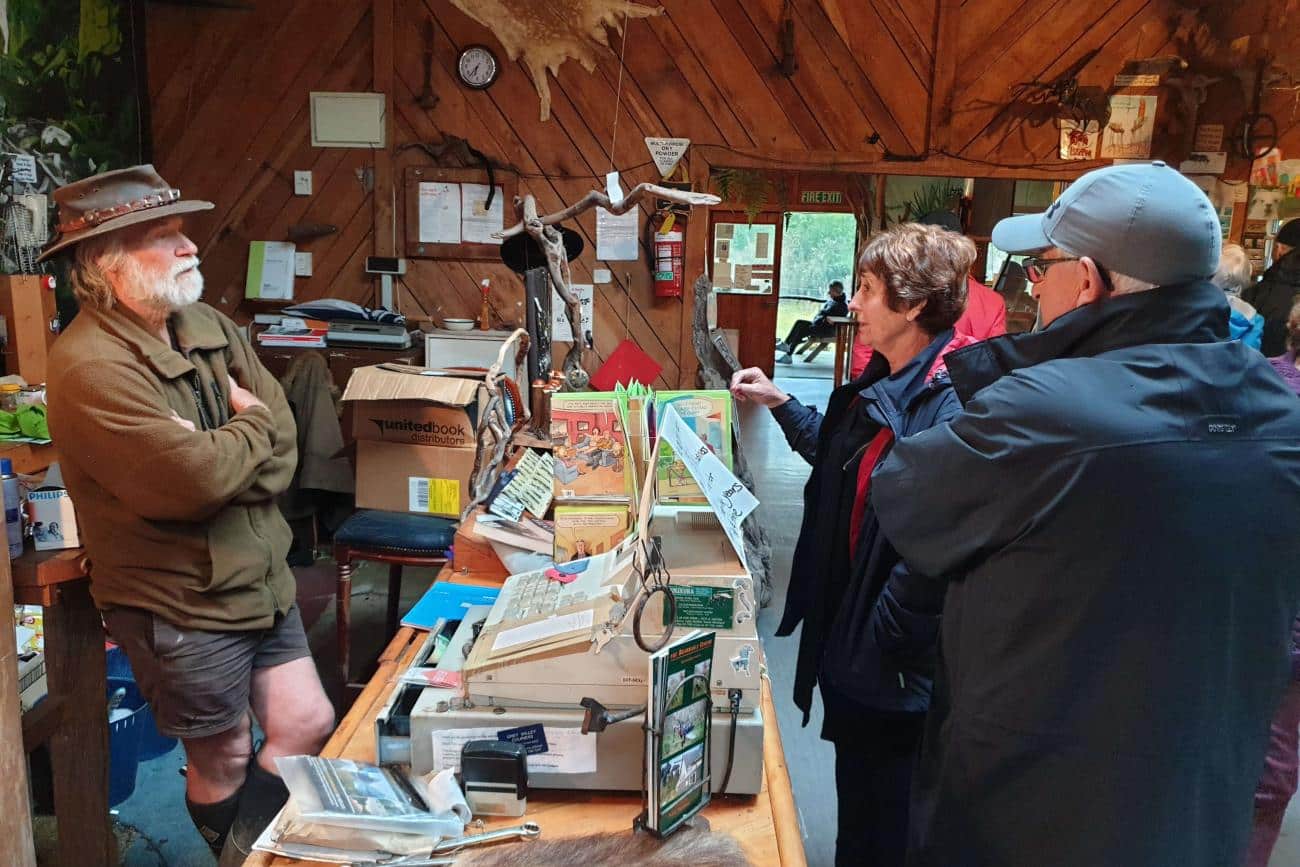
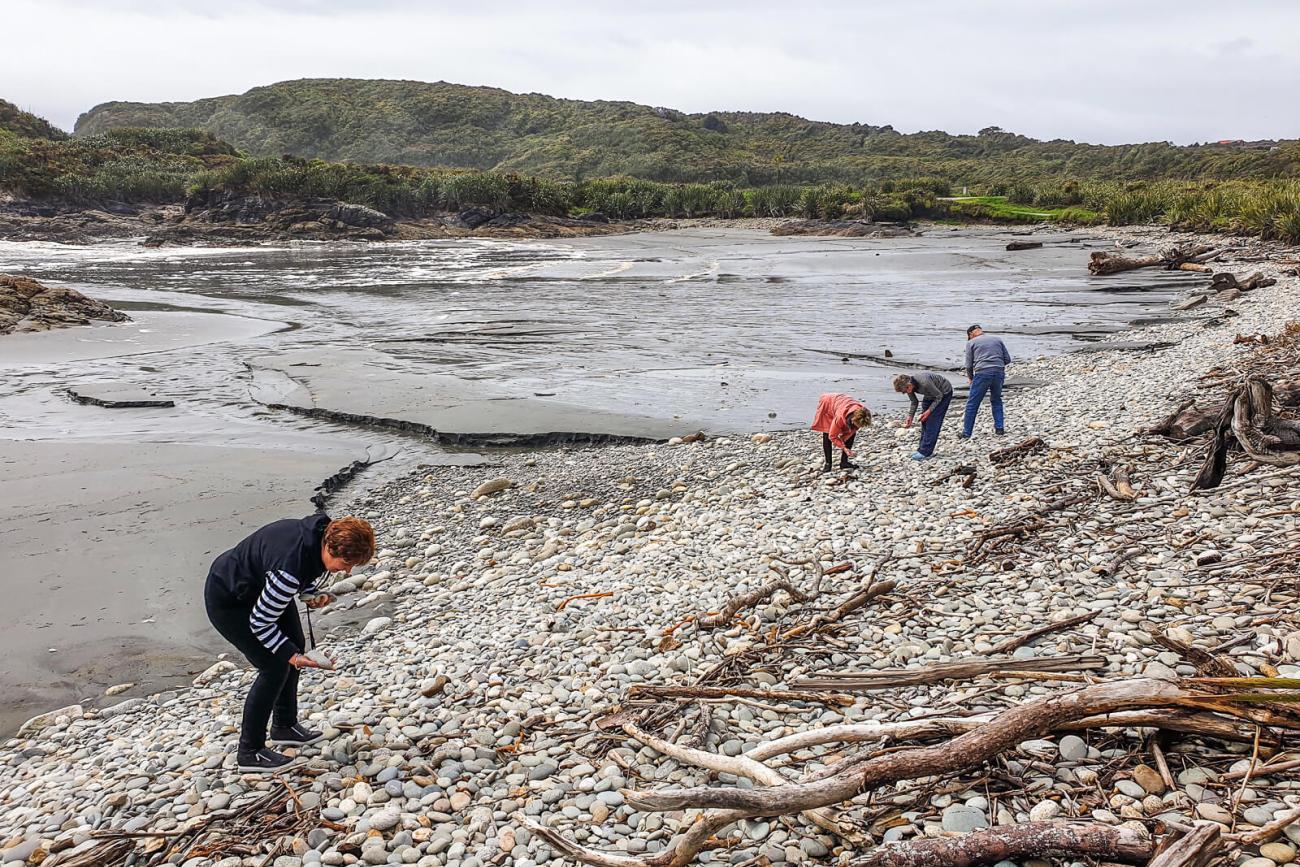
Day 7 – Franz Josef Glacier – Okarito – Hokitika – Punakaiki
Leaving Franz Josef we drove over Mt Hercules, and continued up the Coast. The ocean rollers coming in were very rough and the rain continued unabated. There were flooded areas on the road we had to drive through – with care – and the surrounding paddocks were flooded. One of the farming practices in the area, we were told, is the use of hump-and-hollow paddocks, so that stock can stand on higher ground when it rains and floods – which is often. The river beds were also full of racing torrents rushing under the bridges we crossed.
Drove past several lakes including Lake Ianthe, where in 2013 Tony and I were able to have a ride on a small paddle steamer with Susan and Roger Clarke, friends who were visiting from the UK. The skipper gave Roger the wheel – the smile on ex-yachty Roger’s face that day was worth seeing!
Stopped in Hokitika and spent an hour at various pounamu (greenstone) and artists’ outlets, before driving the last couple of hours to the Ocean View Retreat, in Punakaiki where we will be staying for two nights. It sits right on the beach overlooking the Tasman Sea, with a bluff behind it shielding it from the vagaries of the prevailing westerly weather.
Our group later went to the local pub for tea, where the meals were massive!
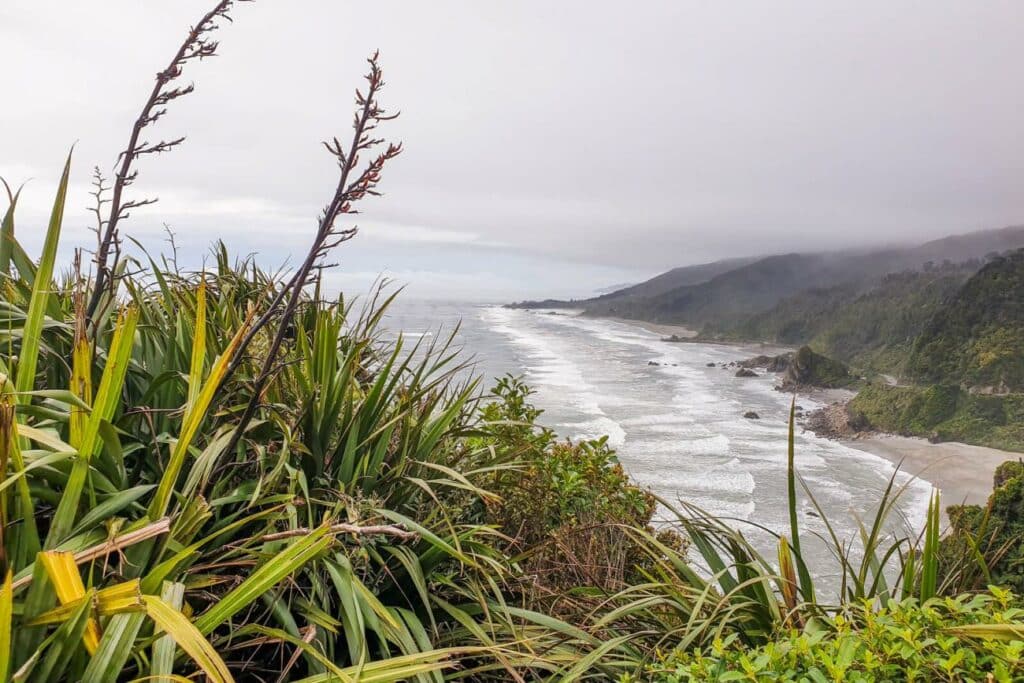
Day 8 – Punakaiki – Westport – Denniston – Cape Foulwind
Our first stop was the nearby blowhole and Punakaiki pancake rocks. As it was full tide we were treated to a great display of the sea’s might as it smashed into the rocks, and plumed up through the blowhole. Although some of us had seen this on a couple of previous trips, we still really enjoyed the show nature provided.
After picking up a coffee from the cafe across the road, we drove north through the area once part of the main 1860s gold rush. We were told the native bush was cleared away at the time, and has taken till now, 160 years later, to regenerate properly. The area was also rich in coal which was mined in huge amounts. There is still a vein of coal obvious on the side of the road at one point, where the locals of today can collect it for free.
Drove on to Cape Foulwind, famous for its seal colony. The name Foulwind could probably be attributed to the smell emanating from the colony, however it was Captain James Cook who named it thus during his visit in 1770, due to his vessel being blown off-course by the strong prevailing westerly – or foul – winds. There were a few seals there, and seabirds whirling off the rocky pillars of the cliff where they nest.
On through Westport, a town supported mainly by coal-mining and commercial fishing. Continuing north we drove up the narrow winding road to the Denniston Plateau high above Westport. This was the site of several coal mines from 1879 through to 1967. Apparently there were three villages originally set up on this windswept, damp and desolate place, separated according to religion. I was going to say “such tunnel vision” but that would be a dreadful pun under the circumstances! The villages were Denniston, Burnett’s Face and Coalbrookdale. Most of the early miners and their families were immigrants from the UK.
What hardship they would have endured, on the trip out to New Zealand to start with, let alone ongoing life in this rugged place.
The mined coal was transported down the side of the Plateau to the railway on the flat below by big bins on a running cable, and this was the only way people and provisions could be transported up and down. Life would have been incredibly hard on the Plateau, not least due to the dangers of the work, the lack of any type of civilisation as Europeans knew it, its remoteness, and the religious segregation. An anonymously-written rhyme possibly said it all:
Damn Denniston
Damn the track
Damn the way both there and back
Damn the wind and damn the weather
God damn Denniston altogether
On the way back to Punakaiki where we were staying a second night, we drove down a side road to Constant Bay, a tiny narrow inlet that was, incredibly, a port for the nearby town of Charleston during the 1860s gold rush. Charleston was founded as the main township when the gold rush started. It is hard to imagine how the sailing ships got through the tiny mouth of the bay, running the gauntlet with the savage Tasman Sea smashing against the coastline. The beach in this little bay was made up of large coloured and textured stones, worn perfectly smooth by the sea. The rock-hound instinct came out in several of our group members and a few stones came back with us.
On our way back to the hotel, it actually stopped raining and the sun came out. However, the constant rain and low mist hanging down over the areas we had travelled through over the last few days somehow fitted the history of them, underlining how hard life was – and possibly still is to some degree.
Tonight we had our final group dinner together at the hotel, overlooking the unrelenting breakers of the Tasman Sea – tomorrow we travel back across the island to Christchurch for the finish of the tour.
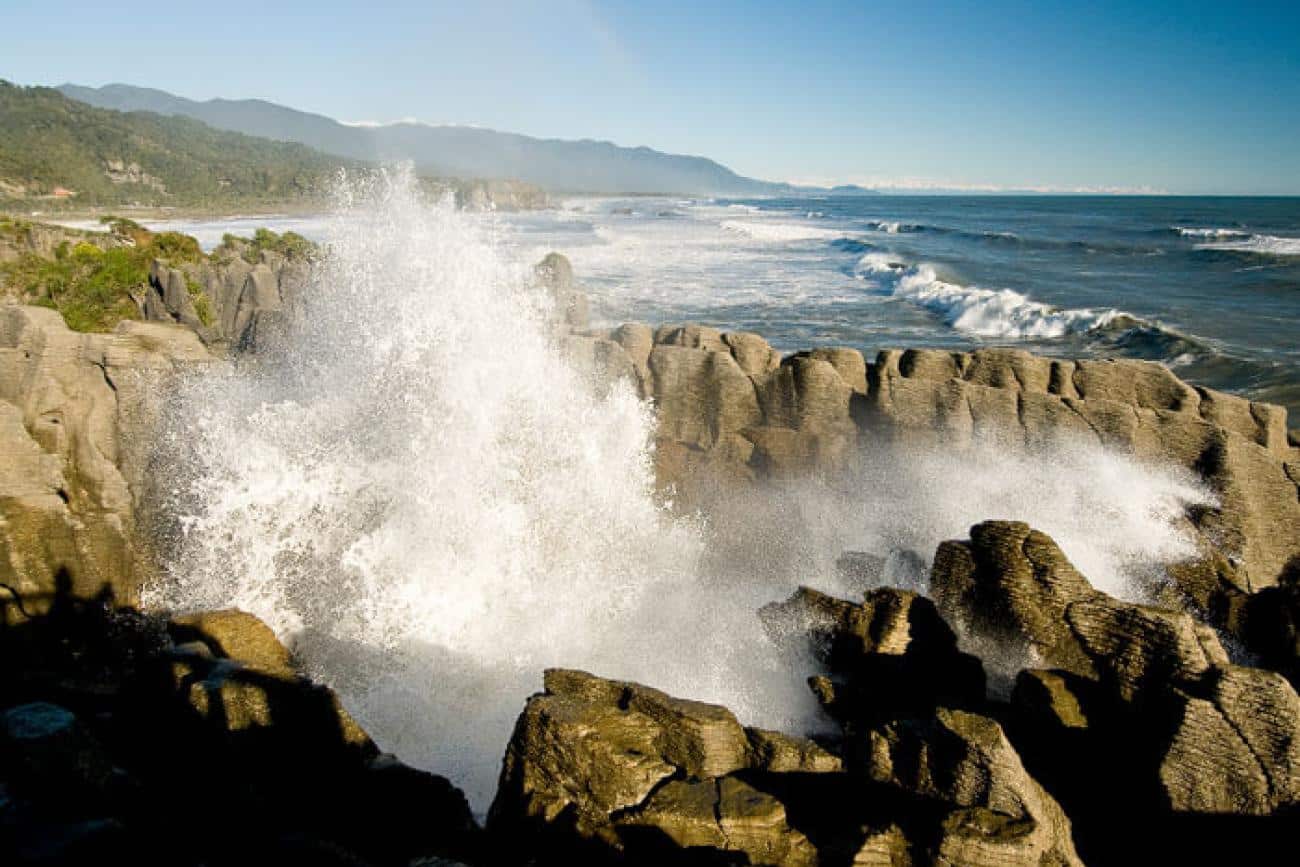
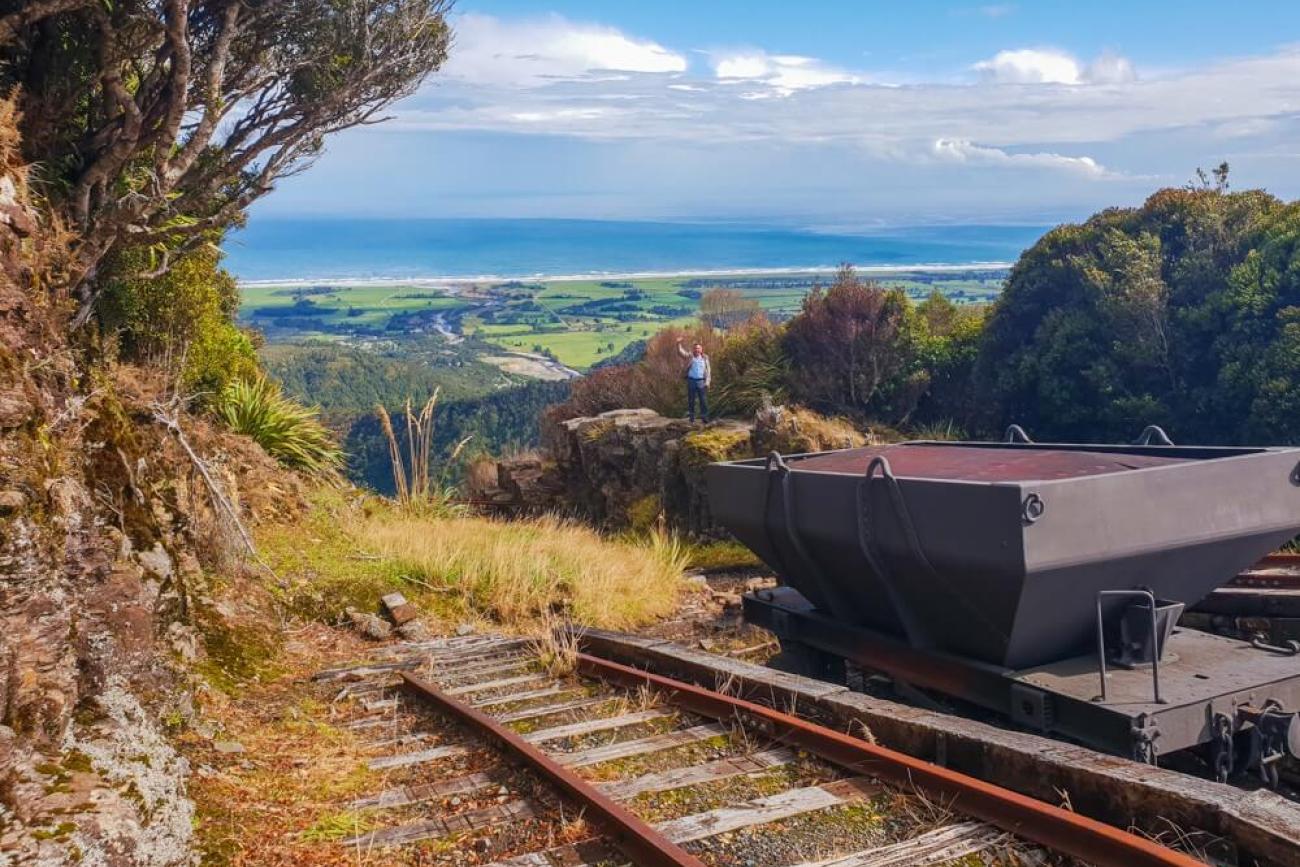
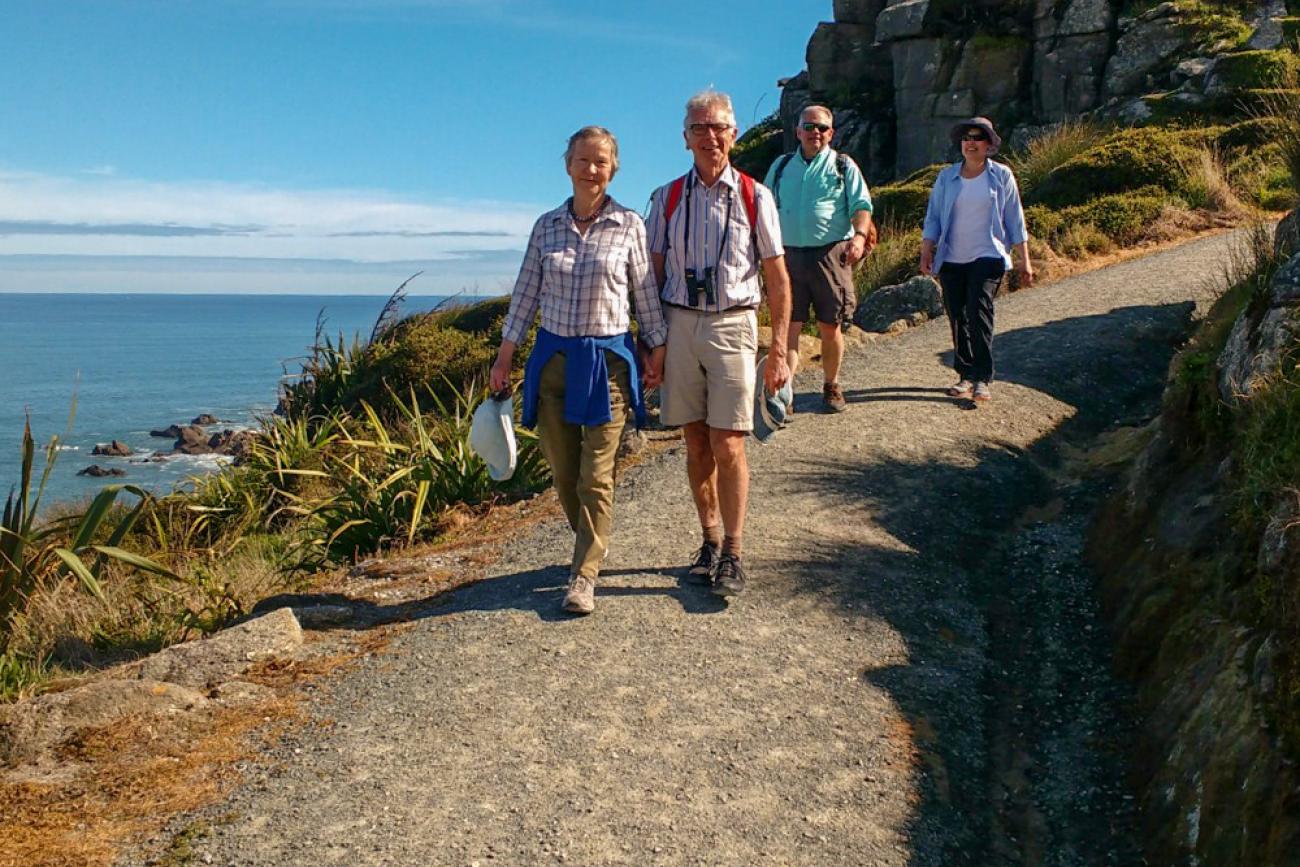
Day 9 – Punakaiki – Arthur’s Pass – Christchurch
Final day on tour – fine and sunny as we left Punakaiki and headed south, then inland on our way across the island to Christchurch. Stopped at the Otira Stagecoach Hotel, first established in 1865 during gold rush days when stagecoaches were the mode of travel between regions. The present 1912 building is the third after the previous two burnt down over the years. An eclectic collection of unusual objects crowd every room, and upstairs there are rooms with four poster beds and heavy wooden furniture from another age, where clients can book in to stay. The publican Lester, who inherited an English title several years back, showed us how different gadgets from the past worked, then went outside and rode a genuine penny farthing cycle around the yard. A very unique establishment, far removed from the modern-day world.
After morning tea at the pub, we continued on through the Otira Gorge to Arthur’s Pass and through the Southern Alps. Otira Viaduct, built in the 1990s, is complete with a rock shelter and water deflector over the road where big rock slides and waterfalls can occur from time to time.
As we drove on, huge ranges of hills continued all around us, with snow-capped mountains behind them – ski fields of the South Island. Very little in the way of trees or vegetation as we went on, the huge expanses of hill slopes barren and stony, with streams running along at their bases, beside the road. We drove through several sheep stations as we progressed on towards the Canterbury Plains.
After driving through Porters Pass, we stopped for lunch in Darfield, at a large bakery/cafe, before continuing down on to the Canterbury Plains and Christchurch Airport. Tony and I were dropped off at our hotel, where we said goodbye to our group.
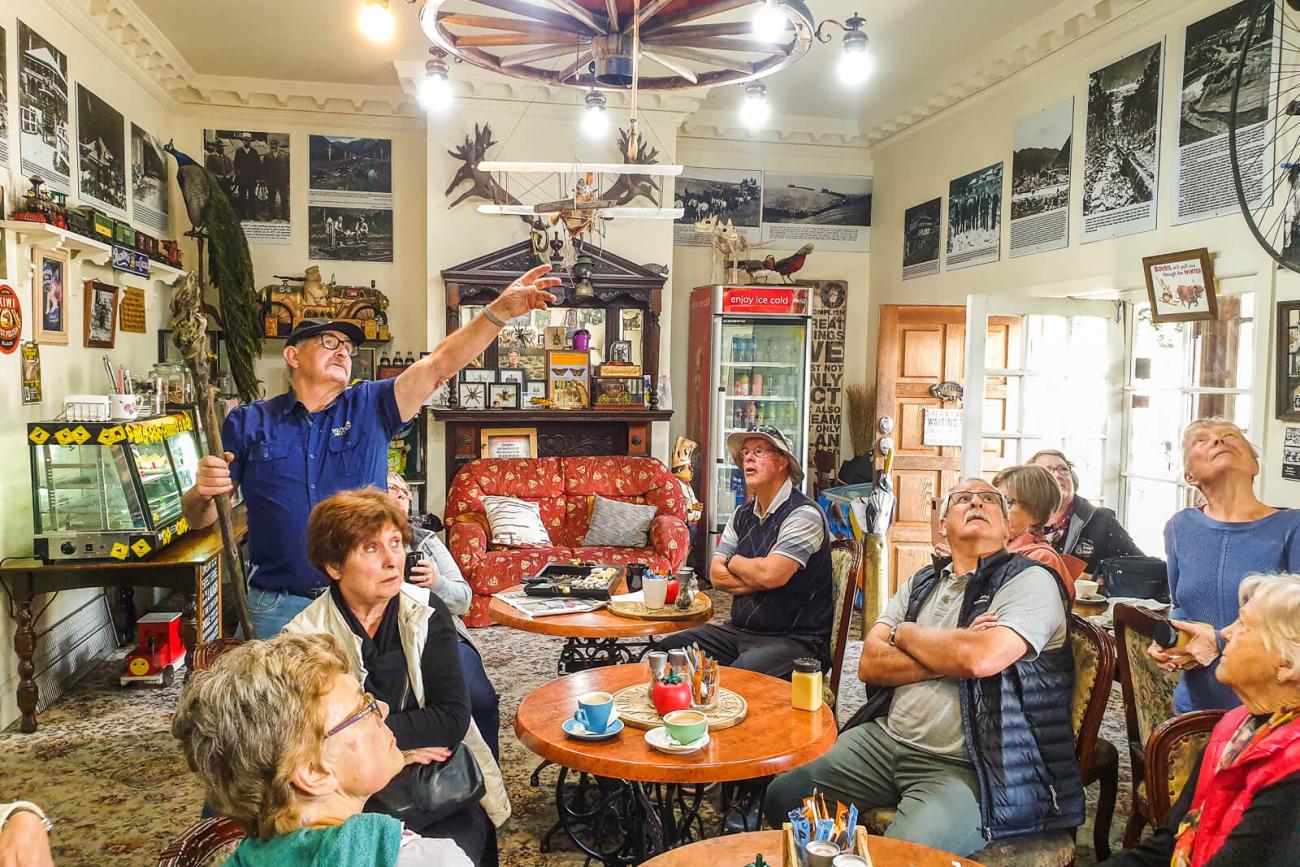
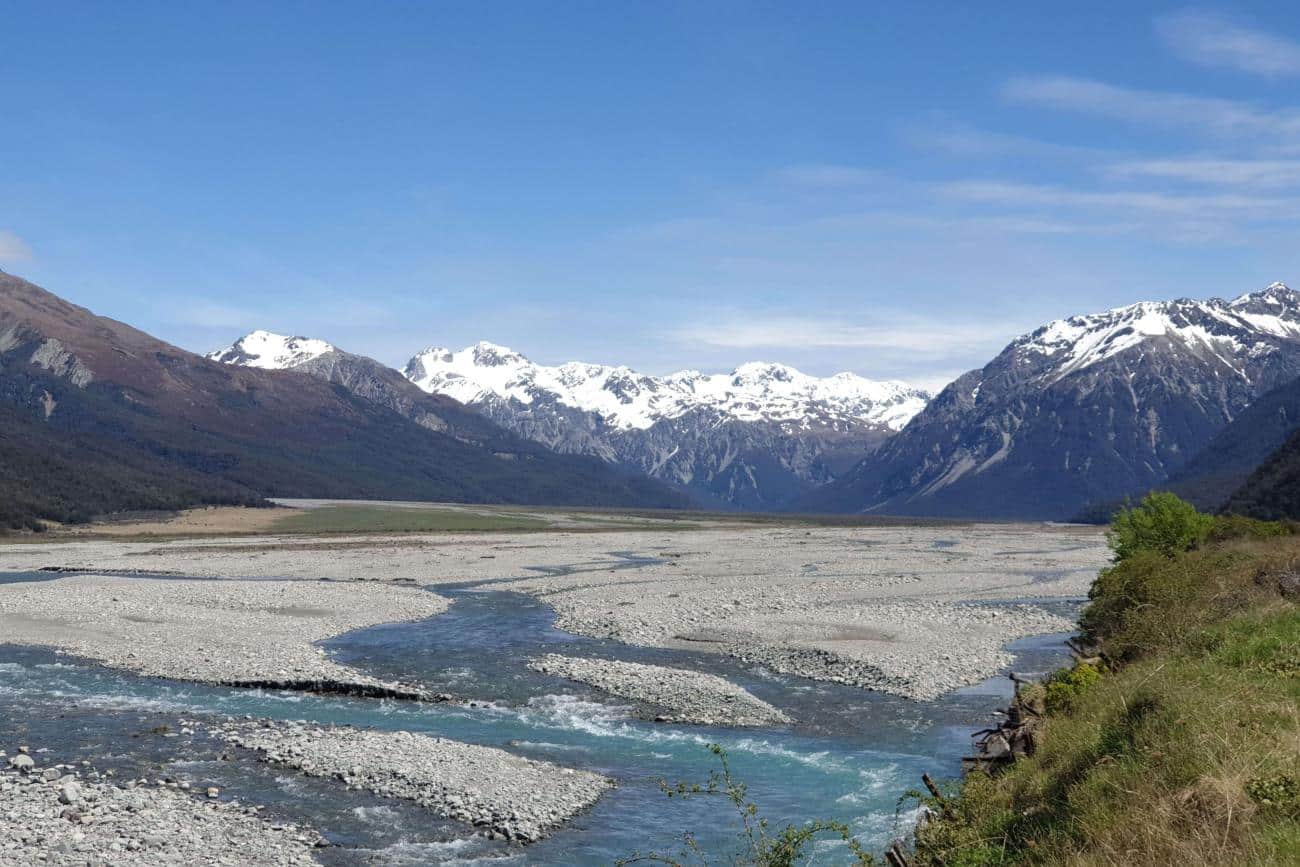
Discover New Zealand’s Kea for yourself
The South Island is stunning, there’s no two ways about it. Whether you’d like to visit the iconic spots like Aoraki/Mt Cook, Queenstown, Milford Sound, Wanaka, Glacier Country and the West Coast for the first time or you’d like to see them again, there’s no easier way than our Kea 9 day tour. An all inclusive, fully guided tour with a maximum of 18 travellers.
Thanks again to Toni for sharing her travel diary from her adventure and of course to her fellow travellers and Kiwi Guide Tim for making it such an entertaining adventure for us all to enjoy.


